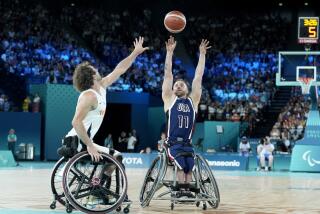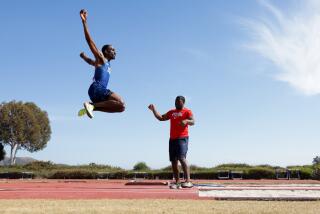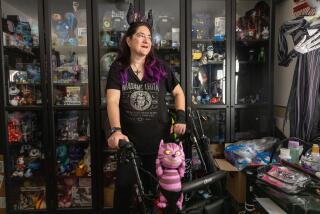Free Floating : Recreation: The underwater world is ‘the great equalizer’ for disabled adventurers in scuba gear.
Beneath the cool waters and gently swaying kelp beds off Anacapa Island, Julie Perez motions to a note board telling her dive buddies she’s going a little deeper to check out the lobsters and some really huge fish.
With a nod, an instructor from the Handicapped Scuba Assn. depresses a button on Perez’s buoyancy vest, sending the Ventura woman to the bottom of the 35-foot waters in a hurry.
“It’s like flying,” Perez of Ventura said after her underwater excursion through the Channel Islands National Park. On Saturday, she was one of about 10 disabled divers from Southern California who experienced a freedom not available to them on land.
Perez, who suffers from muscular dystrophy, was left at age 8 with limited use of her arms and no use of her legs. But when she plunges into the world of the spiny lobster and the stingray, she’s nearly as mobile as an able-bodied person.
“I feel so free right now . . . if people only knew.”
The divers in Perez’s group refer to the ocean as “the great equalizer” because of the weightless effect that it has on them. Normally bound to a wheelchair or crutches, the disabled scuba divers all but grow fins in the water.
Excited dive talk filled the cabin of the 57-foot Encore on Saturday morning as the group motored toward the islands in a light morning fog. One diver talked about a previous trip to the South Pacific, another spoke anxiously about a wet suit modification that would let him probe underwater caves without banging up his knees.
In general, the divers couldn’t wait to get wet.
“But you’ve got to obey the rules,” warned instructor Denise Dowd, who organizes excursions for the 600-member San Clemente-based association. “We’re careful when we take someone down, especially if they have no use of their arms or legs.”
Cold water and currents are the two biggest obstacles facing disabled divers, who must depend on their partners or motorized propulsion devices to get around, Dowd said.
The club uses buddy teams, pairing up handicapped divers with able-bodied divers who are briefed on their partners’ limitations. Buddies will often use a pre-written grease pencil note pad to communicate with each other.
When Dowd descends with Perez, the two must maintain eye contact on the way down to be sure that the pressure isn’t too much.
“If she makes a face, we go back up,” Dowd said.
Once they hit the bottom, Perez channels her cooped-up energies onto a set of special webbed gloves that make it easier for her to scoot about. To get back to the surface, Dowd inflates Perez’s life vest for her.
“I use a conservative dive table to prevent decompression. If the maximum dive time is 50 minutes, we only go down 40 minutes,” Dowd said.
Some of the divers who have complete upper body musculature control need very little assistance. Henry Holden of Van Nuys uses arms as big as legs to race through the water.
“This is all steel,” said Holden, 43, poking at a chest bulked by years in a wheelchair. “In the water, I’m an animal.”
Canyon Country diver Steve Turkheimer, 35, used the excursion to test a new tank-mounted propulsion device that he said turned out to be a flop.
“It doesn’t work right,” said Turkheimer, who is a quadriplegic but has some use of his arms. “Great dive just the same.”
A different type of torpedo-shaped “scooter” helps Terry Luxembourger of Brea dart through the water. Polio left his legs inert when he was 4, but the motorized ride helps him get around faster than his buddy.
“It’s a big role reversal,” said Luxembourger, 44, after leading his dive instructor around the east side of Anacapa for about an hour. “Here’s a gimp taking on an able-bodied diver.”
The good-natured kidding is shared by the captain of the ship, 50-year-old Nicolas Coster, a TV actor from Los Angeles who said that he brings his dog along on the trip “to keep Terry from jumping me.”
Coster began devoting time and resources to the association after suffering temporary paralysis of his right arm.
He purchased the boat, which has an elevator to lift wheelchairs to a flying bridge, and he takes out groups from the Oxnard port about once a month. The next trip is scheduled for Oct. 13, he said.
“The whole objective is to allow them to keep their dignity and have a hell of a lot of fun,” said Coster, a certified instructor with the HSA. “When they get below the surface, impairments start to disappear.”
When he’s not manning the helm, Coster is busy lifting divers in and out of the water, checking equipment and telling tales only a deep-sea fanatic could appreciate.
The Handicapped Scuba Assn., formed in 1975, has trained 400 non-disabled instructors and 200 divers. Some of the divers are para- and quadriplegics. To become certified, divers must swim 200 yards and tread water for 10 minutes.
In August, five members of the association traveled to the Fiji Islands, where they helped the Cousteau Society film a 30-minute documentary about the effects of diving on coral reefs.
A spokeswoman for Cousteau said the film would be out next year.
After a cold dive in the Pacific, Coster and the group scramble for one of two showers to counteract the 60-degree chill of the ocean. Some shivering divers will pour anything hot into their wet suits, including coffee.
“Ahhhh . . . that’s good,” Luxembourger said as he poured piping hot water into his suit. “I feel reborn.”
More to Read
Sign up for The Wild
We’ll help you find the best places to hike, bike and run, as well as the perfect silent spots for meditation and yoga.
You may occasionally receive promotional content from the Los Angeles Times.






